2003 GMC SIERRA DENALI heater
[x] Cancel search: heaterPage 82 of 428

Section 2 Features and Controls
Keys ............................................................... 2-2
Remote Keyless Entry System
......................... 2-3
Remote Keyless Entry System Operation
........... 2-4
Doors and Locks
............................................. 2-6
Door Locks
.................................................... 2-6
Power Door Locks
.......................................... 2-7
Rear Doors
................................................... 2-8
Tailgate
........................................................ 2-8
Windows
........................................................ 2-10
Power Windows
............................................ 2-11
Swing-Out Windows
...................................... 2-11
Sun Visors
................................................... 2-12
Theft-Deterrent Systems
.................................. 2.13
Content Theft-Deterrent
................................. 2.13
Passlock@
.................................................... 2.14
Starting and Operating Your Vehicle
................ 2.15
New Vehicle Break-In
.................................... 2.15
Ignition Positions
.......................................... 2.15
Starting Your Engine
..................................... 2.16
Engine Coolant Heater
.................................. 2.17
Automatic Transmission Operation
................... 2.18
All-Wheel Drive
............................................ 2-21
Parking Brake
.............................................. 2-22
Shifting Into Park
(P) ..................................... 2-23 Shifting
Out
of Park (P) ................................. 2-25
Parking Over Things That Burn
....................... 2-26
Engine Exhaust
............................................ 2-26
Running Your Engine While You Are Parked
.... 2-27
Mirrors
........................................................... 2-28
Automatic Dimming Rearview Mirror with
OnStap, Compass and Temperature
Display
.................................................... 2-28
Outside Power Mirrors
................................... 2-31
Outside Power Foldaway Mirrors
..................... 2-31
Outside Automatic Dimming Mirror
.................. 2-31
Outside Curb View Assist Mirrors
.................... 2-32
Outside Convex Mirror
................................... 2-32
Outside Heated Mirrors
.................................. 2-32
Onstar@ System
............................................. 2-33
HomeLink@ Transmitter
................................... 2-35
Programming the HomeLink Transmitter
........... 2-35
Storage Areas
................................................ 2-39
Glove Box
................................................... 2-39
Cupholder(s)
................................................ 2-39
Center Console Storage Area
......................... 2-39
Tonneau Cover
............................................ 2-39
Vehicle Personalization
................................... 2-42
Memory Seat
............................................... 2-42
2- 1
Page 98 of 428
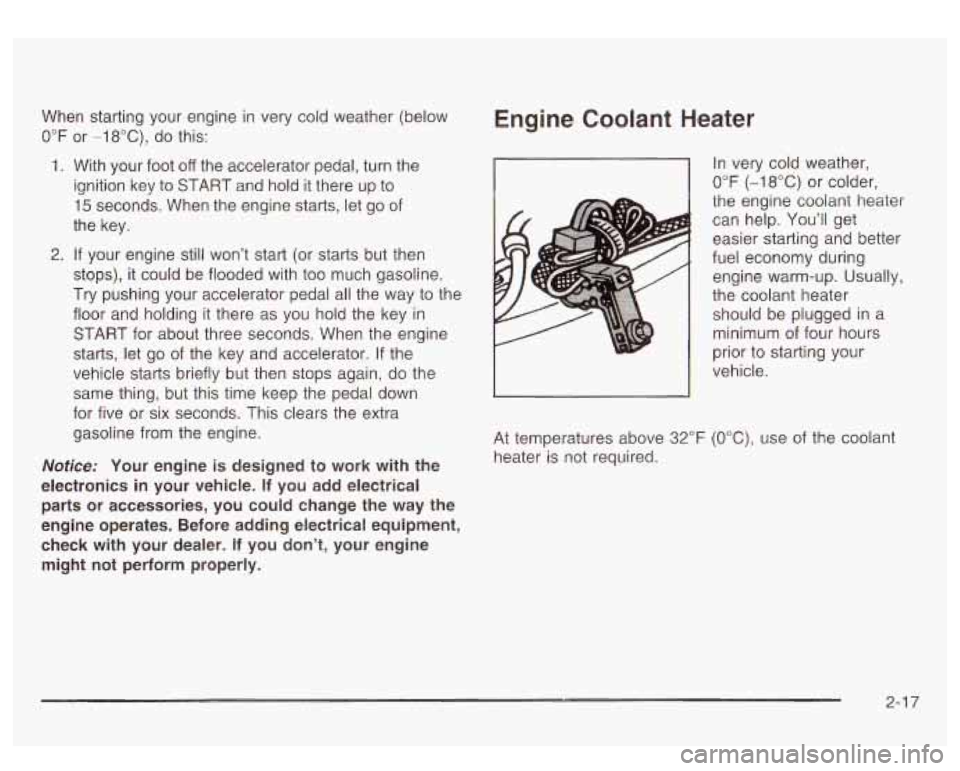
When starting your engine in very cold weather (below
0°F or -18"C), do this:
Engine Coolant Heater
1. With your foot off the accelerator pedal, turn the
ignition key to START and hold it there up to
15 seconds. When the engine starts, let go of
the key.
2. If your engine still won't start (or starts but then
stops), it could be flooded with too much gasoline.
Try pushing your accelerator pedal all the way to the
floor and holding
it there as you hold the key in
START for about three seconds. When the engine
starts, let go of the key and accelerator. If the
vehicle starts briefly but then stops again, do the
same thing, but this time keep the pedal down
for five or six seconds. This clears the extra
gasoline from the engine.
Notice: Your engine is designed to work with the
electronics in your vehicle.
If you add electrical
parts or accessories, you could change the way the
engine operates. Before adding electrical equipment,
check with your dealer.
If you don't, your engine
might not perform properly. In
very cold weather,
0°F (-18°C) or colder,
the engine coolant heater
can help. You'll get
easier starting and better
fuel economy during
engine warm-up. Usually,
the coolant heater
should be plugged in a
minimum of four hours
prior to starting your
vehicle.
At temperatures above
32°F (OOC), use of the coolant
heater is not required.
2-1 7
Page 99 of 428
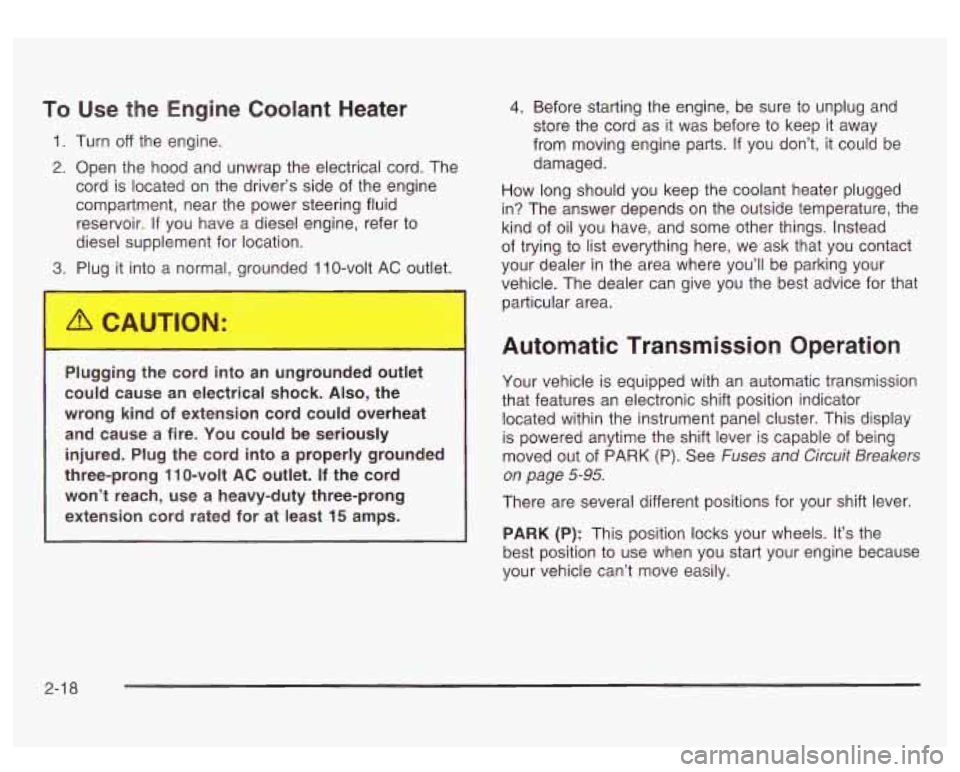
To Use the Engine Coolant Heater
1. Turn off the engine.
2. Open the hood and unwrap the electrical cord. The
cord is located on the driver’s side of the engine
compartment, near the power steering fluid
reservoir. If you have a diesel engine, refer to
diesel supplement for location.
3. Plug it into a normal, grounded 11 0-volt AC outlet.
Plugging the cord into an ungrounded outlet
could cause an electrical shock. Also, the
wrong kind of extension cord could overheat
and cause a fire. You could
be seriously
injured. Plug the cord into a properly grounded
three-prong
11 0-volt AC outlet. If the cord
won’t reach, use a heavy-duty three-prong
extension cord rated for at least
15 amps.
4. Before starting the engine, be sure to unplug ana
store the cord as it was before to keep it away
from moving engine parts.
If you don’t, it could be
damaged.
How long should you keep the coolant heater plugged
in? The answer depends on the outside temperature, the
kind of oil you have, and some other things. Instead
of trying to list everything here, we ask that you contact
your dealer in the area where you’ll be parking your
vehicle. The dealer can give you the best advice for that
particular area.
Automatic Transmission Operation
Your vehicle is equipped with an automatic transmission
that features an electronic shift position indicator
located within the instrument panel cluster. This display
is powered anytime the shift lever
is capable of being
moved out
of PARK (P). See Fuses and Circuit Breakers
on page
5-95.
There are several different positions for your shift lever.
PARK
(P): This position locks your wheels. It’s the
best position to use when you start your engine because
your vehicle can’t move easily.
2-1 8
Page 101 of 428

DRIVE (D) can be used when towing a trailer, carrying a
heavy load, driving on steep hills or for off-road
driving. You may want to shift the transmission to
THIRD
(3) or, if necessary, a lower gear selection if the
transmission shifts too often.
THIRD
(3): This position is also used for normal driving,
however it offers more power and lower fuel economy
than DRIVE (D).
SECOND
(2): This position gives you more power but
lower fuel economy. You can use SECOND
(2) on
hills. It can help control your speed as you go down
steep mountain roads, but then you would also want to
use your brakes occasionally.
If you manually select SECOND
(2), the transmission
will drive in second gear. You may use this feature
for reducing the speed of the rear wheels when you are
trying to start your vehicle from a stop on slippery
road surfaces. FIRST
(1): This position
gives you even more power
(but lower fuel economy) than SECOND
(2). You
can use it on very steep hills, or in deep snow or mud.
If the shift lever is put in FIRST (1) while the vehicle
is moving forward, the transmission won’t shift into first
gear until the vehicle is going slowly enough.
Notice: If your rear wheels won’t turn, don’t try to
drive. This might happen
if you were stuck in
very deep sand or mud or were up against a solid
object. You could damage your transmission.
Also, if you stop when going uphill, don’t hold your
vehicle there with only the accelerator pedal.
This could overheat and damage the transmission.
Use your brakes or shift into PARK (P) to hold
your vehicle in position on a hill.
On cold days, approximately
32°F (OOC) or colder, your
transmission is designed to shift differently until the
engine reaches normal operating temperature. This is
intended to improve heater performance.
2-20
Page 148 of 428
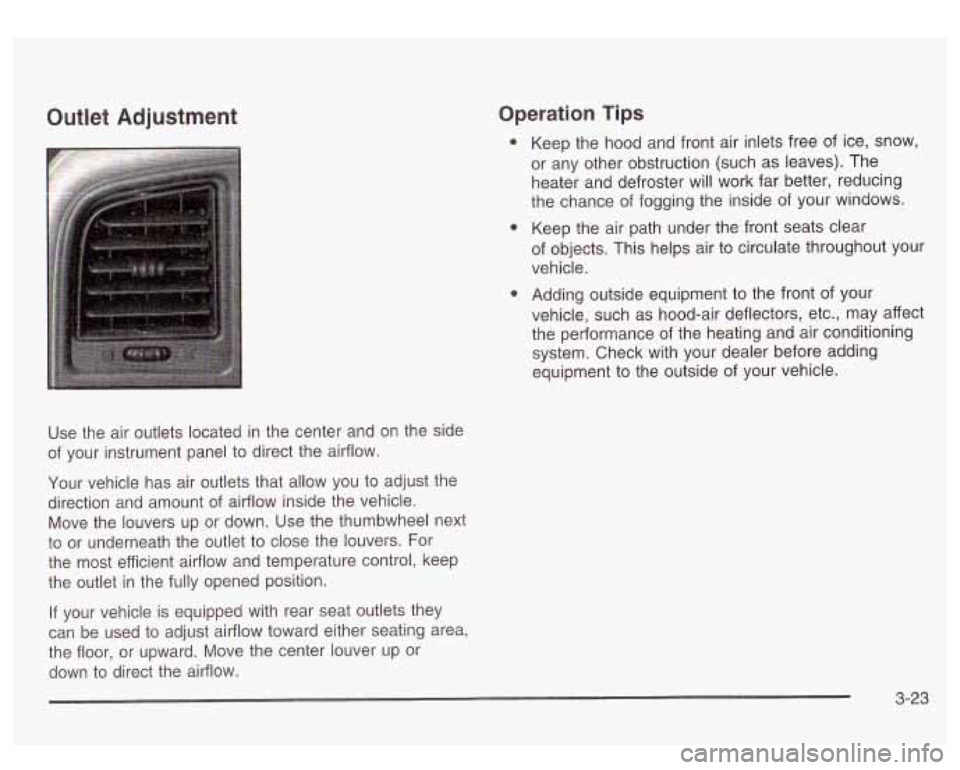
Outlet Adjustment Operation Tips
Use the air outlets located in the center and on the side
of your instrument panel to direct the airflow.
Your vehicle has air outlets that allow you to adjust the
direction and amount of airflow inside the vehicle.
Move the louvers up or down. Use the thumbwheel next
to or underneath the outlet to close the louvers. For
the most efficient airflow and temperature control, keep
the outlet in the fully opened position.
If your vehicle is equipped with rear seat outlets they
can be used
to adjust airflow toward either seating area,
the floor, or upward. Move the center louver up or
down
to direct the airflow. Keep
the hood and front air inlets free
of ice, snow,
or any other obstruction (such as leaves). The
heater and defroster will work far better, reducing
the chance of fogging the inside of your windows.
Keep the air path under the front seats clear
of objects. This helps air
to circulate throughout your
vehicle.
Adding outside equipment
to the front of your
vehicle, such as hood-air deflectors, etc., may affect
the performance
of the heating and air conditioning
system. Check with your dealer before adding
equipment
to the outside of your vehicle.
3-23
Page 250 of 428

Snow can trap exhaust gases under your
vehicle. This can cause deadly CO (carbon
monoxide) gas to get inside. CO could
overcome you and kill you. You can’t see
it or
smell
it, so you might not know it is in your
vehicle. Clear away snow from around the
base of your vehicle, especially any that is
blocking your exhaust pipe. And check around
again from time to time to be sure snow
doesn’t collect there.
Open a window just a little on the side of the
vehicle that’s away from the wind. This will
help keep
CO out. Run your
engine only as long as you must. This saves
fuel. When you run the engine, make it go a little
faster than just idle. That is, push the accelerator
slightly. This uses less fuel for the heat that you get and
it keeps the battery charged.
You will need a
well-charged battery to restart the vehicle, and possibly
for signaling later on with your headlamps. Let the
heater run for a while.
Then, shut the engine
off and close the window almost
all the way to preserve the heat. Start the engine
again and repeat this only when you feel really
uncomfortable from the cold.
But do it as little as
possible. Preserve the fuel as long as you can. To help
keep warm, you can get out of the vehicle and do
some fairly vigorous exercises every half hour or
so until
help comes.
4-41
Page 293 of 428
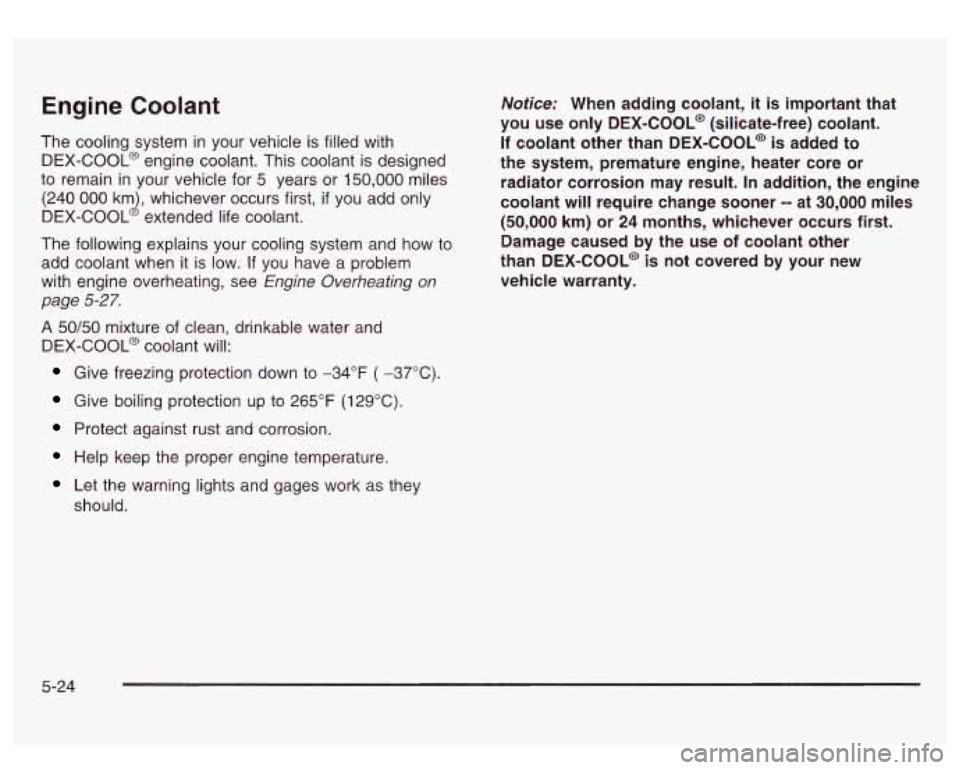
Engine Coolant
The cooling system in your vehicle is filled with
DEX-COOL@ engine coolant. This coolant is designed
to remain in your vehicle for 5 years or 150,000 miles
(240
000 km), whichever occurs first, if you add only
DEX-COOL@ extended life coolant.
The following explains your cooling system and how to
add coolant when
it is low. If you have a problem
with engine overheating, see
Engine Overheating on
page
5-27.
A 50/50 mixture of clean, drinkable water and
DEX-COOL@ coolant will:
Give freezing protection down to -34°F ( -37°C).
Give boiling protection up to 265°F (129°C).
Protect against rust and corrosion.
Help keep the proper engine temperature.
Notice: When adding coolant, it is important that
you use only
DEX-COOL@ (silicate-free) coolant.
If coolant other than DEX-COOL@ is added to
the system, premature engine, heater core or
radiator corrosion may result.
In addition, the engine
coolant
will require change sooner -- at 30,000 miles
(50,000 km) or 24 months, whichever occurs first.
Damage caused by the use
of coolant other
than DEX-COOL@ is not covered by your new
vehicle warranty.
Let the warning lights and gages work as they
should.
5-24
Page 294 of 428
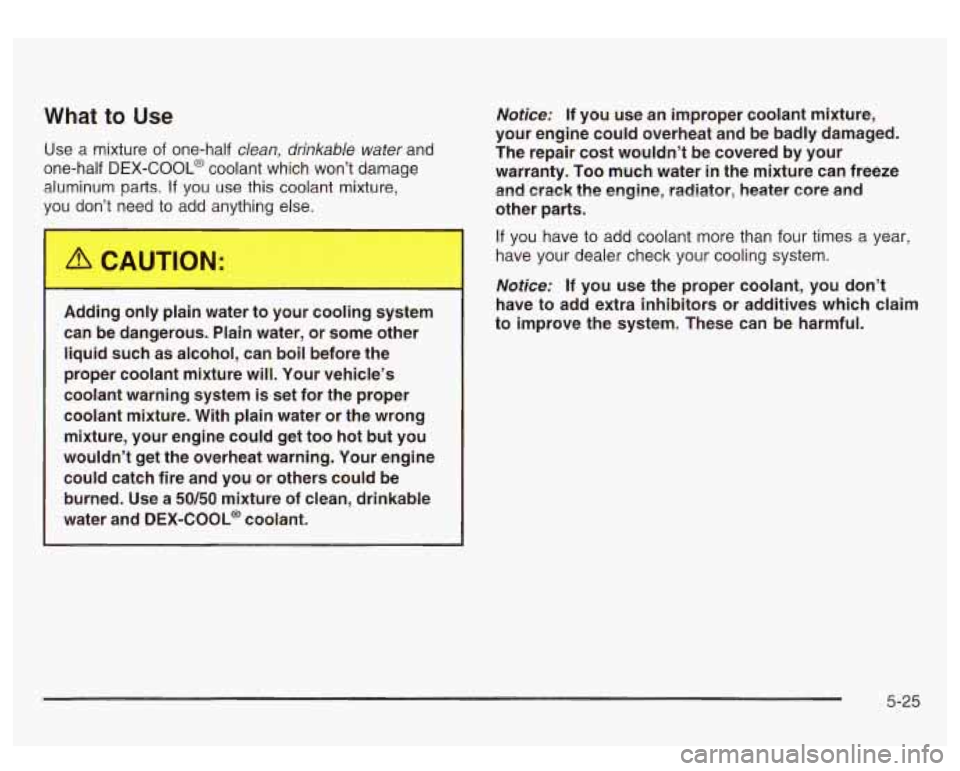
What to Use
Use a mixture of one-half dean, drinkable water and
one-half
DEX-COOL@ coolant which won’t damage
aluminum parts.
If you use this coolant mixture,
vou don’t need
to add anvthing else.
I
Addir - mi- -)lain water to lr cooling s- tem
can be dangerous. Plain water, or some other
liquid such as alcohol, can boil before the
proper coolant mixture will. Your vehicle’s
coolant warning system
is set for the proper
coolant mixture.
With plain water or the wrong
mixture, your engine could get too hot
but you
wouldn’t get the overheat warning. Your engine could catch fire and you or others could be burned. Use a
50/50 mixture of clean, drinkable
water and
DEX-COOL@ coolant.
Notice: If you use an improper coolant mixture,
your engine could overheat and be badly damaged.
The repair cost wouldn’t be covered by your
warranty. Too much water
in the mixture can freeze
and crack the engine, radiator, heater core
and
other parts.
If you have to add coolant more than four times a year,
have your dealer check your cooling system.
Notice: If you use the proper coolant, you don’t
have to add extra inhibitors or additives which claim
to improve the system. These can be harmful.
5-25